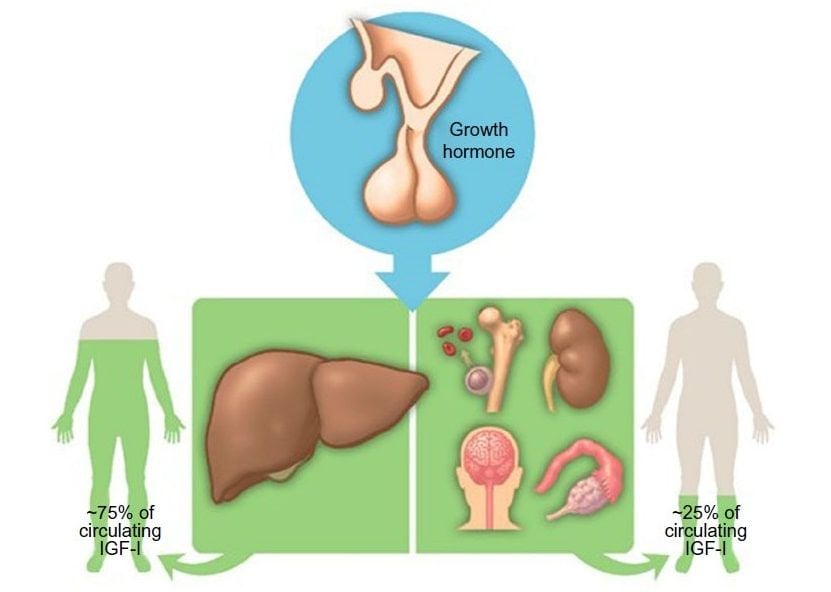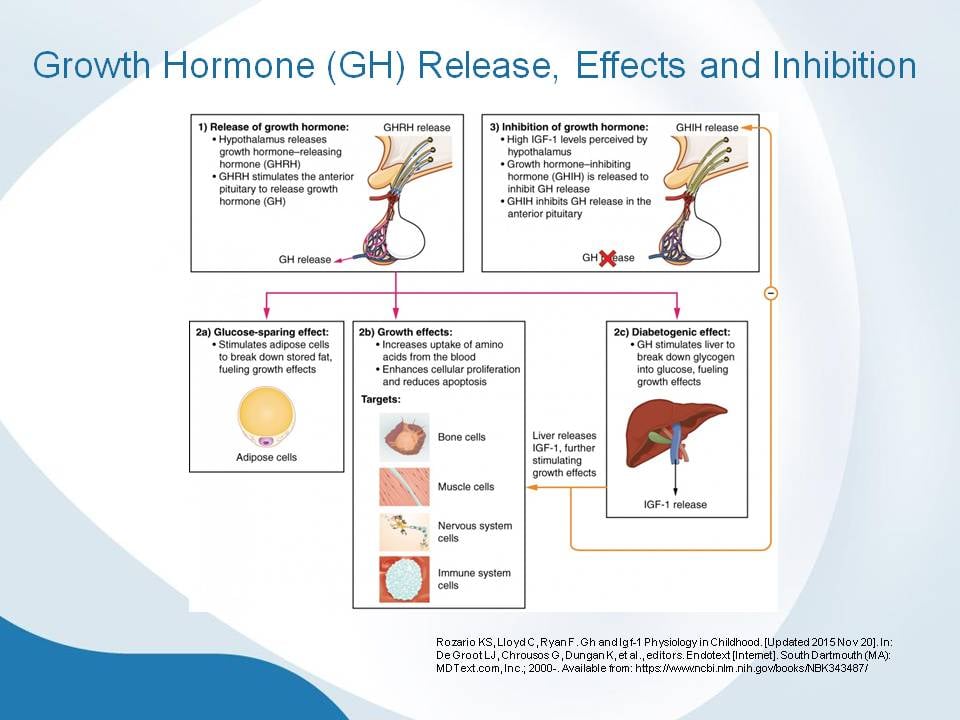IGF-1 Test: Roles and Potential Benefits

IGF-1, or Insulin Growth Factor 1, 1s a hormone in our body that is structurally very similar to insulin. It has a vital role in growth during childhood and adulthood and continues to have anabolic effects. IGF-1 is the primary mediator of the effects of growth hormone, which, most of us know, can benefit the male physique drastically and also has anti-aging effects.
Table of Contents
IGF-1, What is it?
IGF-1 is a hormone in our body that is structurally very similar to insulin. It has a vital role in growth during childhood and adulthood and continues to have anabolic effects. IGF-1 is the primary mediator of the effects of growth hormone, which, most of us know, can benefit the male physique drastically and also has anti-aging effects.
IGF-1 In Relation to Growth Hormone
As stated previously, IGF-1 is the primary mediator of GH secretion. So what exactly does that mean? It all starts in an area of the brain called the hypothalamus. Whenever GH needs to be secreted (GH levels are typically highest during periods of fasting and sleep), the hypothalamus releases growth hormone-releasing hormone (GHRH). This GHRH then binds to receptors in another area of the brain called the anterior pituitary. The anterior pituitary then releases GH into the bloodstream. GH has several effects on the body, including a glucose-sparing effect, meaning that instead of the body utilizing glucose as a primary energy source, the body taps into adipose tissue, using stored fat as energy. In this regard, GH can significantly help burn fat. However, this is not the only favorable action of GH. GH also has several anabolic growth effects. It increases the uptake of amino acids from the blood and increases protein synthesis in skeletal muscle tissue. This anabolism, however, can become problematic because GH also targets bone cells and just about every other cell in the body. Uncontrolled bone growth is a symptom of the condition known as acromegaly, which can result from excessive GH use. The most noticeable feature of someone with acromegaly or HGH abuse is the development of a jagged or uncharacteristically prominent jawline.
Where does IGF-1 come into play?
GH acts directly on the liver to produce IGF-1.
This IGF-1 is then released into the bloodstream to stimulate the growth effects of GH further. These two hormones work synergistically to promote cellular growth effects in bone cells, muscle cells, nervous system cells, immune cells, and just about every cell in our body. GH also has a “diabetogenic effect,” meaning that when GH binds to receptors in the liver, the liver is instructed to break down glycogen into glucose, which fuels growth effects.
Other benefits and effects of IGF-1
Interestingly enough, elevated IGF-1 levels (from elevated GH levels) may potentially benefit erectile dysfunction [1]. In 2011 a paper titled “IGF-1 levels are significantly correlated with patient-reported measures of sexual function” found that growth hormone (GH) supplementation may help to preserve erectile function. Serum insulin-like growth factor 1 (IGF-1) levels, which are a substitute for GH levels, were compared to sexual function scores in 65 men who filled out the Sexual Health Inventory for Men (SHIM) and the Expanded Prostate Cancer Index Composite (EPIC) questionnaires and had their testosterone and IGF-1 levels checked. Median±s.d. IGF-1 level, SHIM, and EPIC scores were 235.0±86.4, 19.5±8.7 and 56.4±28.3 mg ml−1, respectively. IGF-1 levels and total SHIM score correlate significantly (r=0.31, P=0.02), as do IGF-1 levels and all individual SHIM question scores, and IGF-1 levels and the sexual domain of the EPIC questionnaire (r=0.30, P=0.02.
Another study published titled “Men with high levels of anabolic hormones less likely to develop worsening frailty” Proved that having higher baseline levels of vitamin D, insulin-like growth factor-1 (IGF-1), and its binding protein 3 (IGFBP3) was associated with a lower risk of worse frailty status four years later [2]. "Vitamin D, besides maintaining bone health, regulates muscle function, and low vitamin D levels are linked to lower muscle mass and strength. IGF-1 affects muscle growth and repair, and its action and levels are modified by its carrier protein IGFBP3," Swiecicka said.
Higher levels of the hormone dehydroepiandrosterone sulfate (DHEA-S) were also linked to a lower chance of getting frailty status worse. However, this was only true for the oldest men. Several potential pathways could link DHEA-S with frailty. Swiecicka said, "DHEA-S may have direct anabolic effect on muscle, and, more recently, its neuroprotective and immune system-modulating effects have been described."
IGF-1 in Relation to Testosterone
In a study titled “Testosterone administration increases insulin-like growth factor-I levels in normal men.” Researchers discovered just that [4]. Although testosterone (T) administration can increase insulin-like growth factor-I (IGF-I) when administered to hypogonadal men, no studies have examined whether this occurs in normal men. The present study was undertaken to determine if an increase in IGF-I may be part of the anabolic effect of androgens. Researchers enrolled 11 normal men in a randomized, double-blinded cross-over study. Subjects were assigned to receive either T enanthate (TE) (300 mg im, each week) or nandrolone (ND) decanoate (300 mg im, each week) for 6 weeks. After a washout period, subjects were administered the alternate treatment. After acid-ethanol extraction, pre- and post-treatment serum was RIA analyzed for IGF-I. Although GH levels were not significantly different after either TE or ND treatment, they tended to increase after TE treatment (1.23 +/- 0.28 ng/mL vs. 3.3 +/- 1.03 ng/mL) but remained unchanged after ND treatment (1.68 +/- 0.68 ng/mL vs. 1.89 +/- 0.64 ng/mL). Serum total T levels increased 32 +/- 0.05 nmol/L in the TE-treated men but fell by 7 +/- 0.02 nmol/L in the ND-treated men (P < 0.0001). These data indicate that when normal men are given TE, serum IGF-I levels increase after six weeks of treatment.
References:
1. Pastuszak AW, Liu JS, Vij A, Mohamed O, Sathyamoorthy K, Lipshultz LI, Khera M. IGF-1 levels are significantly correlated with patient-reported measures of sexual function. Int J Impot Res. 2011 Sep-Oct;23(5):220-6
2. Smith, Roy G. Human Growth Hormone Research and Clinical Practice.
3. Hobbs CJ, Plymate SR, Rosen CJ, Adler RA. Testosterone administration increases insulin-like growth factor-I levels in normal men. J Clin Endocrinol Metab. 1993 Sep;77(3):776-9.
4. Agnieszka Swiecicka, Mark Lunt, Tomas Ahern, Terence W. O'Neil. Higher Anabolic Hormone Levels Predict Lower Risk of Worsening Frailty in Men: Prospective Results from the European Male Ageing Study. Presented at Endocrine Society Annual Meeting 2017.






